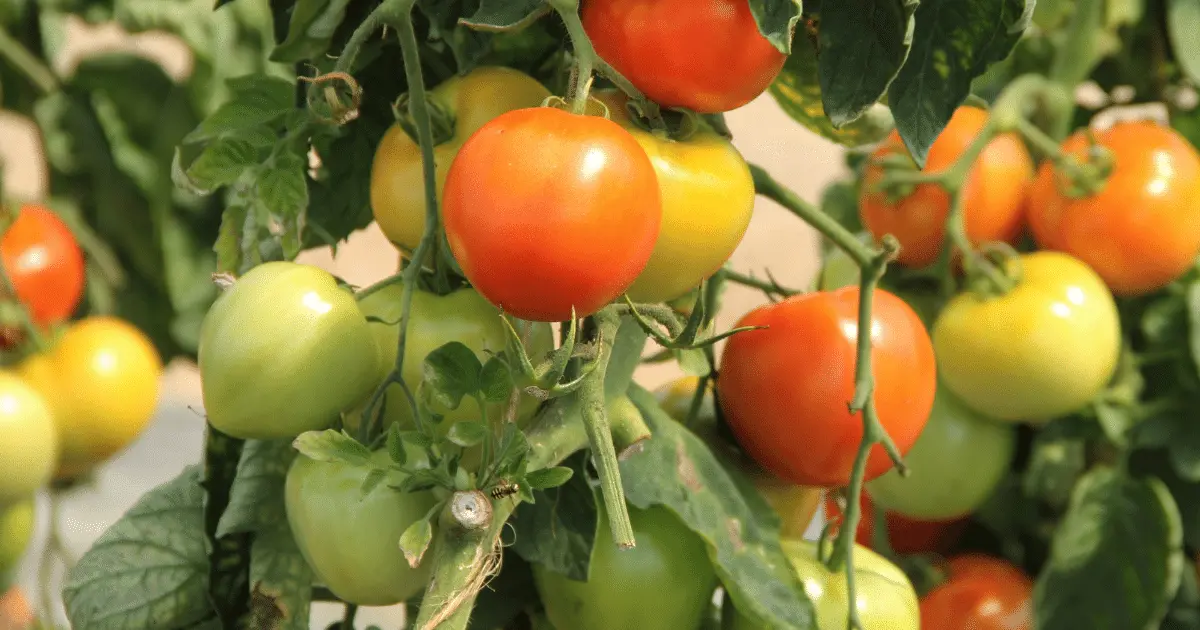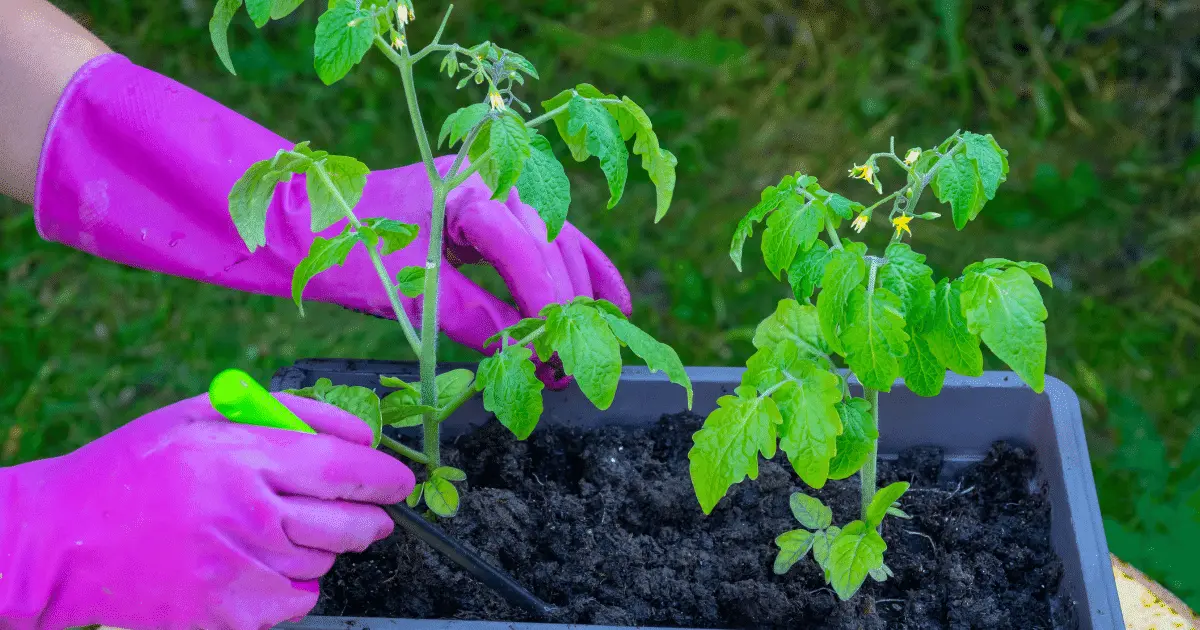I’ve had tomato plants die in my garden, so I understand how disheartening it can be to watch all your laborious efforts go to waste. It’s even more upsetting when it happens yearly.
It took some time for me to realize that maintaining tomato plants requires much more than just providing them with water and nutrients.
Can you Revive a Dying Tomato Plant?
Yes, you can. You don’t have to make the same mistakes I made. There are many approaches to increase your plant’s chances of survival. Let’s examine the potential causes of your tomato plants’ decline and possible solutions.
Watering
Tomato plants dying from improper watering are a common occurrence. Unbelievably, overwatering can be just as damaging to plants as underwatering.
Under Watering
You’ll need to give the plant a lot of water if it’s scorched. Tomato plants enjoy being thoroughly watered, particularly during long, hot days. The plants cannot produce large, juicy fruits without sufficient water, and you will quickly notice wilting in the leaves and stalks.
It would be best if you watered deeply because tomato roots need to penetrate a lot of soil to find enough moisture. This entails letting the water run for a while, so it has enough time to get to the plant’s root system. You should water your tomato plant in a container until the excess water drips from the bottom.
When determining how frequently to water your plants, remember that plants in containers dry out much more quickly than plants in the ground. During extended, hot days, you’ll probably need to water your tomato plants in a container more frequently than once per week.
Over Watering
At the same time, if you overwater your plants, the soil around the roots gets too wet and remains that way. You first need to stop watering your tomato if you believe it has been overwatered. Allow your tomato to dry before watering it again.
Move your plants to a warm, sunny location if they are in pots or containers so they can dry out. You can also aerate the soil if they are in the ground to aid in its drying. This can be accomplished by using a fork or other specific aeration tool to prick the ground around your plant.
In minor instances, this will be sufficient to solve the overwatering issue. However, you should examine your plant’s roots if you suspect root rot. To do this, either take your plant out of its pot or dig around in its soil. If you come across smelly, brown roots, root rot is definitely the cause.
You must completely dig up your plant roots if they have root rot. You’ll need to dig up any tomatoes that are in the ground to perform this task. However, take care not to damage the main root ball.
After exposing the roots, use sterile clippers to remove the affected ones. You must repot your tomato plant after removing the unhealthy roots. Make sure you don’t put it back in the same place if you’re putting it back into the earth. This is because the root rot fungus will affect the surrounding soil. If you’re putting it back into a pot, sterilize the container to avoid reinfection.
How Often Should I Water tomato plants?

There isn’t a set rule for how much water to use; it will vary depending on your location, time of year, climate, soil, and even plant size. Sticking your hand in the soil is a better way to tell. You should water your plants if the soil feels dry a few inches below the surface. You don’t need to water the soil if it’s wet.
Remember These Tips When Watering
There are a few other guidelines for watering. First, it’s preferable to water your plants less often and give them one deep drink that will reach the roots rather than multiple shallow ones so the sun may evaporate.
Additionally, water the plants at a low, soil-level angle. A tomato plant is more likely to develop mold, fungus, or rot if water gets on the stem or leaves.
The optimum time to water your plant is early morning when the sun is low and the air is cooler. This will prevent water from evaporating and allow it to reach the roots.
Simply put: avoid overwatering your plants at all costs. If the soil needs more water, you may always add more, but it’s difficult to remove!
SEE: How to Propagate Peperomia
Incorrect Soil pH
Checking your pH is the logical next step if you believe your watering routine is adequate. Your plant may experience nutrient deficiencies if your pH is either too high or too low. Even if the nutrient is abundant in the soil, this can still happen! The reason for this is that when the pH of the soil is too high or too low, nutrients are less accessible for the plant to soak up through its roots.
You can perform the test yourself by purchasing a soil pH test kit from a nearby garden center or online. You can also collect a soil sample and submit it for analysis to your neighborhood agricultural extension.
For many plants, a pH range of 5.5 to 6.5 is ideal (slightly acidic – a pH of 7.0 is neutral). Some plants prefer more acidic soil, such as blueberries and azaleas. If your pH is slightly off, you can change it for the following season by adding sulfur (to lower pH) or lime (to raise pH). There are other methods of adjusting pH, and you can find admixtures that do so while also giving your plants nutrients.
Nutrient Deficiencies
As said above, soil pH has an impact on a plant’s capacity to absorb nutrients through its roots. Even if the pH of your soil is within an acceptable range, other factors could still make your plants deficient in certain nutrients.
Cold Soil
One effect of cold soil is that plants may take longer to absorb nutrients. If you plant too early or experience a sustained period of unseasonably cold weather, this could become a problem. Plants that are inappropriate for your climate could also cause issues in your garden.
Nutrient Imbalance
A soil nutrient imbalance is another possibility. For instance, even if the soil is rich in magnesium, too much calcium can inhibit your plant from absorbing the mineral. Make sure you are adding only a little of one mineral because gardening is all about balance. You can overfertilize your soil as well, for example, by using an excessive amount of high-nitrogen fertilizer. Once more, using a soil test kit will help you determine whether you have a nutrient imbalance.
Lack of Nutrients in Garden Soil
A soil test might also show that your soil is deficient in a particular nutrient. If your tomato plant leaves turn yellow, this is one indication that you might have a nutrient deficiency in your soil.
Damage During Transplanting

Some gardeners prefer to start their plants from seeds inside before relocating the seedlings once they have grown a little. Some people prefer to purchase mature plants from a garden center. In either case, moving your plants outside runs the risk of damaging them.
For starters, leaving the roots out in the sun for too long might get burned. If you have a lot of plants, plant a few at a time before returning inside to get more. You can also place something that will protect your plants from the sun. Just be careful not to let the sun shield get too hot, or you’ll kill the plants!
The sun is not the only factor that can harm a plant’s roots. Avoid crushing the roots or chopping them off with a trowel when planting a tomato plant to avoid damaging the root system.
Lastly, remember to water the plants after transplanting. Since they are not used to the full sun, they will require water to survive. Another clever technique is to bury your tomato transplant deeply—up to two-thirds of the plant’s height.
Extreme Temperatures
Cold soil can hinder a plant’s ability to absorb nutrients, as was already mentioned. Due to its reduced capacity to transpire, a plant can also be killed by extreme heat and humidity. Since transpiration aids in a plant’s cooling, this might cause overheating and eventual death.
Try relocating your plants to an area with less daytime sun for the upcoming season if they consistently die off on the hottest days of the year. Typically, the midday hours are when the sun is at its strongest.
Too Much or Too Little Sunlight
For optimal health, tomatoes require at least 8 hours of sunlight daily. Too much sun can kill them by drying them out or stressing them out, especially if you also make other mistakes (not enough water, etc.) While shade won’t necessarily kill your plants, too little sun will prevent them from developing and bearing fruit as they should.
Diseases

If your tomatoes are well-watered and appear to wilt more after being watered, there is a good possibility that they have a fungal wilt. Verticillium or Fusarium wilt fungi are the two types of fungi that cause fungal wilt in tomatoes. Both have similar effects, causing tomato plants to wilt and die quickly as the fungus clogs the plant’s vascular system. Identifying the particular fungus responsible for the wilted tomato plants can be challenging.
Southern Blight is another fungal wilt that affects tomatoes. In addition to the plant wilting quickly, this fungus can also be recognized by the development of white mold on the soil around the plant’s base.
Unfortunately, none of these fungi can be treated, so any tomato plants that are wilting as a result of them should be removed instantly. Additionally, you shouldn’t plant any nightshade vegetables in that area for at least a year and possibly two years. If despite rotating tomatoes to different locations in your garden, you still experience problems with Verticillium wilt and Fusarium wilt, you can buy plants that are resistant to these fungi.
Pests
Numerous garden pests can kill your tomato plants or, at the very least, weaken your plants, making them produce less fruit.
The following are some typical pests that cause harmful effects on tomato plants:
- Aphid
- Cutworm
- Tomato Hornworm
- Slugs
- Rats
Insects like whiteflies and stink bugs may be controlled using several low-toxicity pesticides made from natural substances like neem, rosemary, and peppermint spray oils. Kaolin clay and insecticidal soap are other pest management tools.
You should now be able to identify the issue that is causing your tomato plants to perish. Hopefully, you now have a starting point for a plan to assist them in recovering or preventing the problem from recurring.
